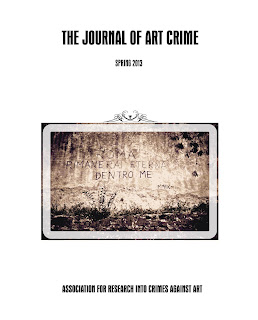Friday, August 02, 2013 -  art insurance,Dorit Straus,erik nemeth,Oplontis,Pompeii
art insurance,Dorit Straus,erik nemeth,Oplontis,Pompeii
 No comments
No comments
 art insurance,Dorit Straus,erik nemeth,Oplontis,Pompeii
art insurance,Dorit Straus,erik nemeth,Oplontis,Pompeii
 No comments
No comments
Report from ARCA in Amelia: Dorit Straus teaches "Insurance Claims and the Art Market"; Erik Nemeth finishes course on cultural security; and students visit Pompeii and Oplontis with Acting Academic Director Crispin Corrado
 |
| Dorit Straus |
by Summer Kelley-Bell, ARCA Intern
This
week brought us the amazing Dorit Straus, who taught "Insurance Claims and the
Art Market". Until her recent
retirement, Ms. Straus worked as the Worldwide Fine Art Specialty Manager for
Chubb Personal Insurance. Prior to
that, she studied archaeology at Hebrew University and worked in a variety of
different museums. The combination
of these two careers meant that Ms. Straus was able to offer us a truly unique
classroom experience. Her class
was shorter than most, a mere two and a half days to the usual five, but by the
end the students were clamoring for more time. Through her, we learned about the complexities involved in
insuring different types of collections and the steps that are taken in the
event of a loss. I don’t think I’m
alone in thinking that her class was the sleeper hit of the summer. Who would have guessed that art
insurance could be so fascinating? In this case, I think we owe a lot to our professor. Ms. Straus was able to distill the
important concepts of the art insurance world in understandable and interesting
ways. Towards the end of her
section, she had the class split into groups to create our own insurance
situation. This process helped to
solidify the ideas we had been presented with in class and was an excellent
means of studying for Straus’ final test.
Ms.
Straus’ class was offset by the end of Dr. Erik Nemeth’s section on cultural
security. For the end this class,
we looked at the idea of legalizing the trade in antiquities as a possible way
of stopping destruction of sites. This sparked intense debate among the students and led to some rather
entertaining class discussions. Dr. Nemeth’s class finished up with an epic exam where students were
asked to find a way to encourage different groups of people to care about art
crime. We were told to come up
with a project and try to find funding for it in sectors that do not usually
work within the art world. It
worked well as a way to sum up everything Dr. Nemeth had been teaching us about
interdisciplinary collaboration and how it can be used to help protect art.
 |
| "Ducks" of Oplontis |
For years scholars believed that this sea facing villa was uninhabited at the time of the eruption as there were no human remains found in the Villa "A" portion of the structure. Even so, walking through its many rooms gave me a very real sense of their presence. This viewpoint changed dramatically when researchers discovered 54 skeletons in one of the large ground-floor rooms in the Villa "B" portion of the site, an area that opens onto the southern portico. Here, men, women and children, some rich, others apparently not, had gathered to wait, perhaps hoping rescue from the unfolding tragedy would come from the sea.
The fact that we can still learn new things from a site such as Oplontis over the course of many years underscores why we need to not only protect sites such as this from decay, but to continue studying them. We can learn many things about our past from Oplontis and its marvelous ducks and if we teach people about the importance of preservation instead of just herding tourists through by the thousands, we might be able to protect our cultural heritage long enough to uncover even more important discoveries about our past.
I have learned to love the villa at Oplontis and I will never look at ducks, or those who painted them, the same again.
I have learned to love the villa at Oplontis and I will never look at ducks, or those who painted them, the same again.





